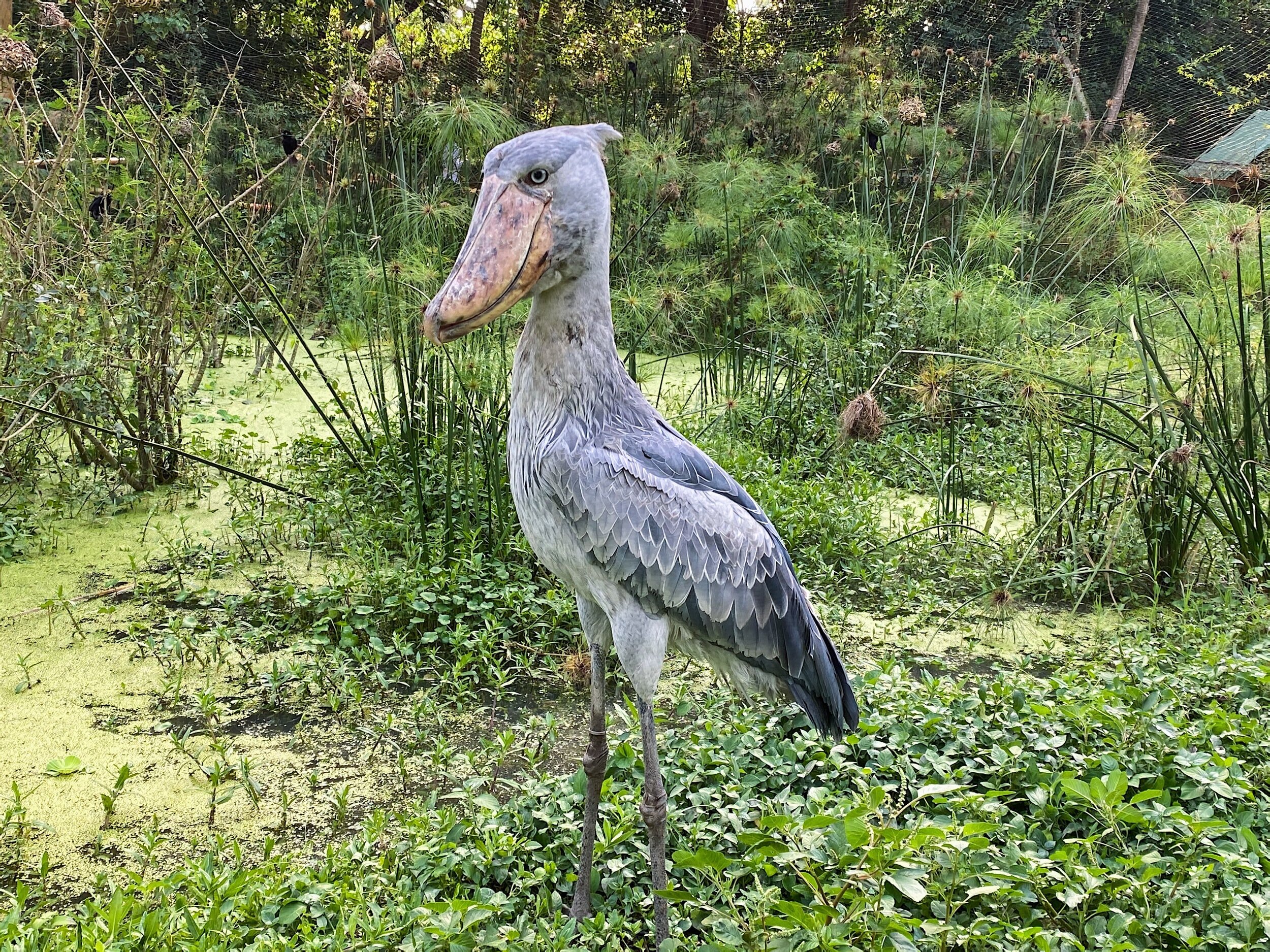Species Spotlight: Shoebill
Common name: Shoebill, Shoebill Stork, Whalehead, Whale-headed stork
Scientific name: Balaeniceps rex
Range: East Africa
Conservation status: Vulnerable on the IUCN Red List
INFORMATION
The Shoebill (Balaeniceps rex) is a large-bodied, long-legged water bird named for its enormous shoe-shaped bill. The species is native to wetland regions of central and east Africa with a majority found in South Sudan, Uganda, eastern Democratic Republic of Congo, and Zambia. Shoebills can usually be found in or along poorly oxygenated waters like swamps, marshes, and bogs where they spend a majority of their time wading slowly or standing motionless before quickly collapsing upon unsuspecting prey - mainly large fish that come to the surface to breathe. Their diets include a considerable range of wetland vertebrates, although they are primarily piscivorous. Hancock, James A.; Kushan (1992).
According to the IUCN, the current global wild population of Shoebills is estimated to be between 5,000 to 8,000, equating to approximately 3,300 to 5,300 mature individuals. The species is categorized as vulnerable on the basis of a continuing decline - a trend showing no signs of slowing without more aggressive conservation measures.
THREATS AND CONSERVATION
Shoebills have endured a long history of exploitation for human consumption and persecution by some local cultures that believe these birds to be symbols of a bad omen. In addition to hunting, habitat conversion and degradation related to agriculture, dam construction, natural resource extraction, and other human activities are markedly diminishing the quality and extent of suitable swamplands. Climate change and associated droughts are further compounding these threats.
Capture for commercial trade (both national and international) poses a significant threat to the Shoebill species as eggs and chicks are known to command a high price (more than $10,000 USD) in the caged bird trade and for display in zoos and private collections. While trade in the species is prohibited in all range states, law enforcement and policing resource capacity is ineffective in curbing illegal trade. Additionally, a low breeding success rate in captivity (only two known occurrences to date) and high rate of mortality in transit maintain pressure on the wild population to satisfy an ongoing demand.
The Shoebill has been included on Appendix II of the Convention on International Trade of Endangered Species of Wild Flora and Fauna (CITES) since 1987. According to the UNEP-WCMC CITES Trade Database, 152 live, wild-caught Shoebills for commercial trade or zoological display (78 and 82 respectively) were recorded by importing countries from 1990 - 2019. While these numbers appear to be insignificant from a population perspective, it is likely that they do not account for a high number of individuals that never complete the journey. For example, on one occasion 4 Shoebills were recorded as exported to Belgium from Tanzania. However, these 4 were the only survivors of at least 20 (see Dodman, 2013).
Not surprising given their tropical origin, Shoebills are sensitive to cool temperatures and susceptible to hypothermia and frostbite. They also suffer from a variety of inflammatory foot conditions including Bumblefoot (pododermatitis) - also unsurprising for a bird that is specifically adapted to spend a majority of its time standing in still wetland waters. Fragility outside of their natural environment both in transit and in long term captivity raises serious animal welfare concerns as well as questions around whether continued capture from the wild for any purpose may have detrimental consequences for the species.
Considering the species’ historical and ongoing decline, decrease in area and quality of its specialized habitat, and continued exploitation, conservation measures must be enhanced if the Shoebill species is to persist. In light of the significant role both national and international trade have played in the Shoebill's decline, heightened protection under CITES Appendix I is essential to the continued existence of this species and should be prioritized. Research, monitoring, and enforcement at the local level should also be supported however possible as well as education campaigns and opportunities for community participation.
REFERENCES
Dodman, T. (compiler) 2013. International Single Species Action Plan for the Conservation of the Shoebill Balaeniceps rex. AEWA Technical Series No. 51. Bonn, Germany
Evon, Dan. Is the Shoebill Stork a Real Animal? Snopes, 7May 2018. https://www.snopes.com/fact-check/shoebill-stork-real-animal/
Hancock, James A.; Kushan (1992). Storks, ibises and spoonbills of the world. London: Academic Press/Harcourt Brace Jovanovich, Publishers. ISBN 0-12-322730-5. OCLC 26933579.
Muir, A.; King, C. E. (January 2013). "Management and husbandry guidelines for Shoebills Balaeniceps rex in captivity: Shoebill: Management and Husbandry Guidelines". International Zoo Yearbook. 47 (1): 181–189. doi:10.1111/j.1748-1090.2012.00186.x.
BirdLife International: Africa. Released: a conservation plan for the Shoebill, king of the marshes, 10 March 2014.
About the Author: Yueqi Yang is a law student at George Washington University specializing in animal law.


